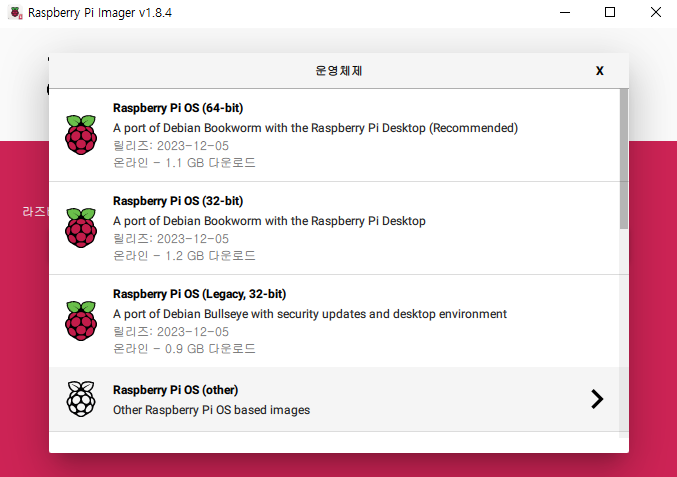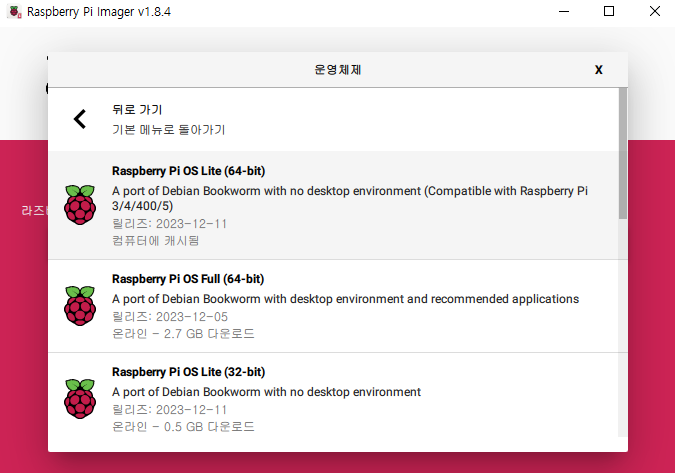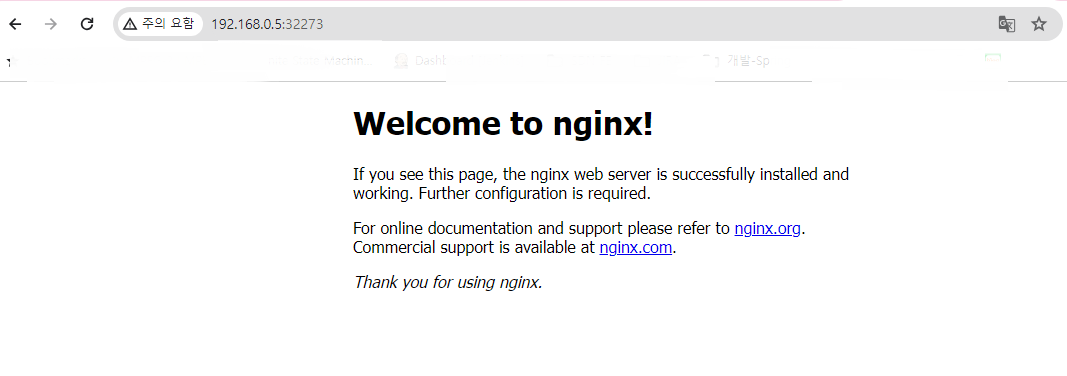How to establish kubernetes cluster using Raspberry Pi OS
Prepare Raspberry-pi OS image using imager


Setting up raspberry-pi OS
Update OS and repo
sudo apt update -y && sudo apt dist-upgrade -y
reboot
sudo reboot
Disable and uninstall swap
sudo dphys-swapfile swapoff
sudo dphys-swapfile uninstall
sudo apt purge -y dphys-swapfile
sudo apt autoremove -y
Add cgroups
echo " cgroup_enable=cpuset cgroup_enable=memory cgroup_memory=1" | sudo tee -a /boot/cmdline.txt
Disable and uninstall swap
sudo dphys-swapfile swapoff
sudo dphys-swapfile uninstall
sudo apt purge -y dphys-swapfile
sudo apt autoremove -y
Or update cmdline
cat /proc/cmdline
coherent_pool=1M 8250.nr_uarts=0 snd_bcm2835.enable_headphones=0 snd_bcm2835.enable_headphones=1 snd_bcm2835.enable_hdmi=1 snd_bcm2835.enable_hdmi=0 smsc95xx.macaddr=D8:3A:DD:24:4E:4F vc_mem.mem_base=0x3eb00000 vc_mem.mem_size=0x3ff00000 cgroup_enable=memory cgroup_memory=1 console=ttyS0,115200 console=tty1 root=PARTUUID=48d96ea9-02 rootfstype=ext4 fsck.repair=yes rootwait
Install and update containerd
sudo apt install -y containerd containernetworking-plugins
cat <<EOF | sudo tee /etc/containerd/config.toml
version = 2
[plugins]
[plugins."io.containerd.grpc.v1.cri"]
[plugins."io.containerd.grpc.v1.cri".containerd]
[plugins."io.containerd.grpc.v1.cri".containerd.runtimes]
[plugins."io.containerd.grpc.v1.cri".containerd.runtimes.runc]
runtime_type = "io.containerd.runc.v2"
[plugins."io.containerd.grpc.v1.cri".containerd.runtimes.runc.options]
SystemdCgroup = true
EOF
Install kubeadm, kubectl and kubelet
sudo apt update
sudo apt install -y apt-transport-https ca-certificates curl
// Download the Google Cloud public signing key:
sudo curl -fsSLo /usr/share/keyrings/kubernetes-archive-keyring.gpg https://dl.k8s.io/apt/doc/apt-key.gpg
// Add the Kubernetes apt repository:
echo "deb [signed-by=/usr/share/keyrings/kubernetes-archive-keyring.gpg] https://apt.kubernetes.io/ kubernetes-xenial main" | sudo tee /etc/apt/sources.list.d/kubernetes.list
// Update `apt` package index, install kubelet, kubeadm and kubectl, and pin their version:
sudo apt update
sudo apt install -y kubelet kubeadm kubectl
sudo apt-mark hold kubelet kubeadm kubectl
Prepare master node
kubeadm init
sudo kubeadm init --pod-network-cidr 192.168.0.0/16
...
...
You should now deploy a pod network to the cluster.
Run "kubectl apply -f [podnetwork].yaml" with one of the options listed at:
https://kubernetes.io/docs/concepts/cluster-administration/addons/
Then you can join any number of worker nodes by running the following on each as root:
kubeadm join 192.168.0.5:6443 --token tplxfo.kd2imdc9ykxj32oo \
--discovery-token-ca-cert-hash sha256:3e56a146c0ef5e12a802c6e2053bd5d8e292e623a0a980de492de885566dc361
Install CNI(Calico)
curl https://raw.githubusercontent.com/projectcalico/calico/v3.26.1/manifests/calico.yaml
kubectl apply -f ./calico.yaml
...
...
customresourcedefinition.apiextensions.k8s.io/networksets.crd.projectcalico.org created
clusterrole.rbac.authorization.k8s.io/calico-kube-controllers created
clusterrole.rbac.authorization.k8s.io/calico-node created
clusterrole.rbac.authorization.k8s.io/calico-cni-plugin created
clusterrolebinding.rbac.authorization.k8s.io/calico-kube-controllers created
clusterrolebinding.rbac.authorization.k8s.io/calico-node created
clusterrolebinding.rbac.authorization.k8s.io/calico-cni-plugin created
daemonset.apps/calico-node created
deployment.apps/calico-kube-controllers created
Prepare worker nde
kubeadm join(on each worker node)
hugh@worker1:~ $ sudo kubeadm join 192.168.0.5:6443 --token tplxfo.kd2imdc9ykxj32oo \
--discovery-token-ca-cert-hash sha256:3e56a146c0ef5e12a802c6e2053bd5d8e292e623a0a980de492de885566dc361
[preflight] Running pre-flight checks
[WARNING SystemVerification]: missing optional cgroups: hugetlb
[preflight] Reading configuration from the cluster...
[preflight] FYI: You can look at this config file with 'kubectl -n kube-system get cm kubeadm-config -o yaml'
[kubelet-start] Writing kubelet configuration to file "/var/lib/kubelet/config.yaml"
[kubelet-start] Writing kubelet environment file with flags to file "/var/lib/kubelet/kubeadm-flags.env"
[kubelet-start] Starting the kubelet
[kubelet-start] Waiting for the kubelet to perform the TLS Bootstrap...
This node has joined the cluster:
* Certificate signing request was sent to apiserver and a response was received.
* The Kubelet was informed of the new secure connection details.
Run 'kubectl get nodes' on the control-plane to see this node join the cluster.
hugh@worker1:~ $
Done
hugh@master:~ $ kubectl get po -A
NAMESPACE NAME READY STATUS RESTARTS AGE
kube-system calico-kube-controllers-7ddc4f45bc-9pnx2 1/1 Running 0 56m
kube-system calico-node-47qww 1/1 Running 0 17m
kube-system calico-node-7jhns 1/1 Running 0 56m
kube-system calico-node-bcc6k 1/1 Running 0 17m
kube-system calico-node-ktb4h 1/1 Running 0 17m
kube-system coredns-5dd5756b68-2v7jg 1/1 Running 0 58m
kube-system coredns-5dd5756b68-5mzgx 1/1 Running 0 58m
kube-system etcd-master 1/1 Running 5 59m
kube-system kube-apiserver-master 1/1 Running 7 59m
kube-system kube-controller-manager-master 1/1 Running 0 59m
kube-system kube-proxy-4frxk 1/1 Running 0 17m
kube-system kube-proxy-bsxdb 1/1 Running 0 17m
kube-system kube-proxy-pc8ld 1/1 Running 0 17m
kube-system kube-proxy-scnbt 1/1 Running 0 58m
kube-system kube-scheduler-master 1/1 Running 9 59m
Test - deployment
Create nginx deployment
kubectl create deployment nginx --image=nginx
deployment.apps/nginx created
Expose NodePort
kubectl expose deployment nginx --type=NodePort --port=80 --target-port=80
service/nginx exposed
Access nginx via exposed port
nginx exposes 32273 port. Let’s access web page through the port.
kubectl get svc -A
NAMESPACE NAME TYPE CLUSTER-IP EXTERNAL-IP PORT(S) AGE
default kubernetes ClusterIP 10.96.0.1 <none> 443/TCP 62m
default nginx NodePort 10.103.92.240 <none> 80:32273/TCP 8s
kube-system kube-dns ClusterIP 10.96.0.10 <none> 53/UDP,53/TCP,9153/TCP 62m
